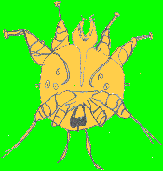
Sarcoptic Mange
(ALSO CALLED "SCABIES")
THE ORGANISM AND HOW IT LIVES
SARCOPTES SCABEI
Sarcoptic mange is the name for the skin disease caused by infection with the Sarcoptes scabei mite. Mites are not insects; instead they are more closely related to spiders. They are microscopic and cannot be seen with the naked eye.

SARCOPTES SCABEI
Adult Sarcoptes scabei mites live 3-4 weeks in the host's skin. After mating, the female burrows into the skin depositing 3-4 eggs in the tunnel behind her. The eggs hatch in 3-10 days producing a larva which, in turn, moves about on the skin surface eventually molting into a "nymphal" stage and finally into an adult. The adults move on the surface of the skin where they mate and the cycle begins again with the female burrowing and laying eggs.
Female sarcoptes mite burrowing in the skin and leaving a trail of eggs behind her. Her presence generates an inflamatory response in the skin similar to an allergic response.

APPEARANCE OF THE DISEASE
The motion of the mite in and on the skin is extremely itchy. Further, the presence of mites and their eggs generates a massive allergic response in the skin which is even more itchy.

Dog with dematitis problem typical of sacrcoptic mange.
Note: Many dogs do not develop the classical ear margin crusts until later in the disease.
Mites prefer hairless skin thus leaving the ear flaps, elbows and abdomen at highest risk for the red, scaley itchy skin that characterizes sarcoptic mange. It should be noted that this pattern of itching is similar to that found with inhalational allergies (atopy) as well as with food allergies. Frequently, before attempting to sort out allergies, a veterinarian will simply treat a patient for sarcoptic mange as a precaution. It is very easy to be led down the wrong path (pursuing allergy aggressively) if one considers sarcoptic mange an unusual or unlikely possibility.
As the infection progresses, eventually most of the dog's body will be involved. Classically, though, the picture begins on the ears (especially the ear margins), the elbows, and abdomen.
The term "Scabies" refers to mite infestations by either Sarcoptes scabei or other mite species closely related to Sarcoptes scabei. While Sarcoptes scabei can infect humans and cats, it tends not to persist on these hosts. When people (including some veterinarians) refer to "sarcoptic mange" or "scabies" in the cat, they are usually referring to infection by Notoedres cati, a mite closely related to Sarcoptes scabei. In these feline cases, it would be more correct to refer to "Notoedric mange," though the treatment for both mites is the same. Notoedric mange, in cats, generally produces facial itching and scabbing.
DIAGNOSIS
When an animal with sarcoptic mange scratches itself, it breaks open the tunnels that the mites have burrowed into and the mites are killed (though the itch persists due to toxins in the skin). The result is that the mites can be very difficult to confirm by skin scraping tests. (Probably mites are confirmed in 50% or fewer of sarcoptic mange cases).
Since negative test results do not rule out mite infection, a "Maybe Mange" test is frequently performed. This consists simply of treating for sarcoptic mange and observing for resolution of the signs within 2-4 weeks.
Of course, if mite presence is confirmed by skin scraping, then one knows immediately the cause of the itching and need not be concerned about allergy possibilities or other diseases and the condition can be addressed with confidence.
BIOPSY - Mange mites are rarely seen on a skin biopsy sample, though, if the sample is read out by a pathologist who specializes in skin, the type of inflammation seen in the sample can be highly suggestive of sarcoptic mange. This is an example of a skin disease where it makes a difference whether the pathologist reading the sample specializes in reading skin samples.
TREATMENT
While sarcoptic mange is difficult to diagnose definitively, it is fairly easy to treat and a number of choices are available.
DIPPING - Anti-bacterial or anti-itch shampoos preceed one of several anti-mite dips. Paramite dip (an organophosphate), Mitaban dip (Amitraz), and Lime-Sulfur dips given weekly are usually effective. Disease typically resolves within one month. Dips are often used in combination with one of the other treatments listed below.
IVERMECTIN - Ivermectin is the active ingredient in Heartgard brand heartworm preventive, though the doses used in Heartgard are too small to affect sarcoptic mange mites. Higher doses are usually obtained by using other formulations of ivermectin and the ivermectin is given either orally or by injection. There are many protocols to treat sarcoptic mange with ivermectin but usually treatments are weekly or every 2 weeks for a month. Occasionally, a longer course of treatment is required.
IT IS IMPORTANT TO NOTE THAT LETHAL TOXIC REACTIONS
IN SENSITIVE INDIVIDUALS (ESPECIALLY COLLIE AND
AUSTRALIAN SHEPHERD BREEDS) HAVE BEEN REPORTED
IF THIS DRUG IS NOT USED APPROPRIATELY.
DO NOT ATTEMPT TO DOSE IVERMECTIN BY YOURSELF.
FIPRONIL (FRONTLINE) - The recommended monthly use of Frontline flea control products may not be reliable against sarcoptes scabei. Some veterinary dermatologists have used more frequent dosing with success. While we know that Fipronil has at least some activity against sarcoptic mange mites, we recommend one of the more "tried and true" products.
ALL DOGS IN A HOUSEHOLD WHERE
SARCOPTIC MANGE HAS BEEN DIAGNOSED
SHOULD BE TREATED.
Obviously, this makes the "maybe mange" test somewhat problematic if there are multiple dogs in the house. Cats should be treated as well if they are in contact with infected dogs.
SELAMECTIN (REVOLUTION) - Selamectin is an ivermectin derivative recently marketed for the control of fleas, roundworms, hookworms, ticks, ear mites and sarcoptic mange mites. Normal monthly use of this product should clear a sarcoptic mange problem and prevent further infections. This product is probably the best choice for collie or Australian shepherd breeds.
HOW THE INFECTION IS SPREAD
Sarcoptic mange mites are usually spread by direct contact from host to host. While mites can live off of a host for days to weeks depending on their life stage, they are only infective for 36 hours which means that environmental decontamination is generally not necessary.
Mite infections on humans are self-limiting (ie they go away on their own) as the mite is not able to complete its life cycle on the "wrong" host. The condition is extremely itchy, though, while it lasts. The mites are most active where skin is warm (in bed and where clothing is snug).
IF A SARCOPTIC MANGE ANIMAL IS PRESENT IN THE HOME,
IT IS A GOOD IDEA TO WASH ANY BEDDING IN
THE WASHING MACHINE (OR REPLACE WITH NEW BEDDING),
AND WASH ANY COLLARS OR HARNESSES.

[ View
My Guestbook ] [ Sign
My Guestbook ]